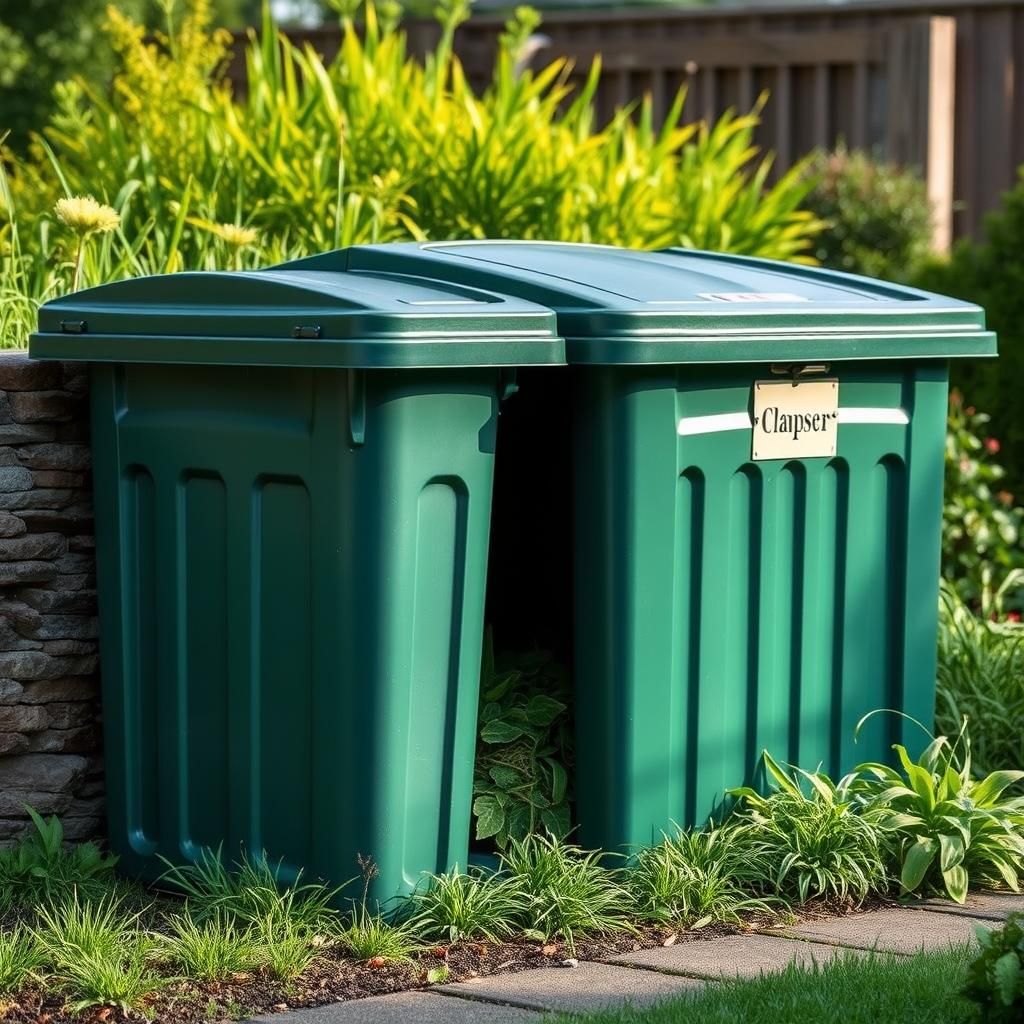Ultimate Guide to Choosing the Best Compost Bin for Grass Clippings

Composting is an essential practice for maintaining a healthy garden and reducing waste. Grass clippings, a common byproduct of lawn maintenance, can become a valuable resource when properly composted. However, choosing the right compost bin is crucial to ensure efficient decomposition and optimal results. With so many options available, it can be overwhelming to determine which type best suits your needs. This ultimate guide will provide you with everything you need to know to select the perfect compost bin for your grass clippings, taking into account factors like size, materials, and design, ultimately helping you create nutrient-rich compost for your garden.
Creating an Effective Compost Bin for Grass Clippings
A compost bin designed specifically for grass clippings can greatly enhance your gardening efforts by transforming waste into nutrient-rich compost. Grass clippings are a valuable green material due to their high nitrogen content, which is essential for the composting process. By utilizing a bin, you can manage moisture levels and aeration more effectively, leading to faster decomposition. It's important to balance the green grass clippings with brown materials like dried leaves or straw to avoid issues such as odor and slow breakdown. With the right setup, grass clippings can enrich your soil, promote healthy plant growth, and reduce waste in landfills.
Benefits of Composting Grass Clippings
Composting grass clippings provides numerous benefits for gardeners and the environment. Firstly, it reduces the volume of yard waste that would typically end up in landfills, thus helping to decrease overall waste. Secondly, decomposed grass clippings yield a rich, organic compost that enhances soil quality, improves drainage, and increases nutrient availability for plants. Additionally, composting promotes a healthier lawn by returning essential nutrients back into the soil, which can lead to thicker, greener grass. Overall, incorporating grass clippings into compost significantly contributes to sustainable gardening practices.
Best Practices for Composting Grass Clippings
To effectively compost grass clippings, adhere to several best practices. Start by chopping or shredding the clippings into smaller pieces to accelerate decomposition. Make sure to layer the grass clippings with brown materials like shredded paper, dry leaves, or straw to maintain a balanced carbon-to-nitrogen ratio. Regularly turning the compost pile helps to improve aeration and speeds up the breakdown process. Moreover, maintaining appropriate moisture levels is crucial; the pile should feel like a damp sponge but not soggy, to avoid anaerobic conditions. Following these practices will result in a rich compost in a shorter timeframe.
Choosing the Right Compost Bin
Selecting the right compost bin is vital to successfully decomposing grass clippings. Options range from static bins made of wood or plastic to rotating drums that facilitate easier mixing. A bin with adequate ventilation is crucial as it allows proper air circulation, which is necessary for aerobic decomposition. Ensure the bin is large enough to hold the volume of clippings produced, while also being easy to access for turning and maintenance. Consider transparent designs or composting thermometers that allow you to monitor temperatures, ensuring the composting process is progressing properly.
See also:
Common Problems When Composting Grass Clippings
Composting grass clippings can lead to common problems that gardeners should be aware of. One of the most frequent issues is the occurrence of foul odors, often caused by too many green materials without sufficient browns or inadequate aeration. To combat this, ensure a proper mix of materials and regularly turn the pile. Another issue may arise from matted clumps of grass clippings that can hinder airflow. To prevent this, spread the clippings evenly in thin layers rather than dumping large quantities at once. Addressing these problems promptly will lead to a healthier composting environment.
Using Compost from Grass Clippings in Your Garden
Once the compost is ready, it can be utilized in various gardening applications. The finished compost can be used to enrich the soil in garden beds, providing essential nutrients to crops and flowers. It can also serve as a top dressing for lawn areas to improve soil structure and enhance the grass's growth. Furthermore, this nutrient-rich compost can be mixed into potting soil for container plants, promoting healthy roots and robust foliage. Applying compost derived from grass clippings not only benefits your garden but also reinforces eco-friendly practices by recycling organic waste.
| Aspect | Details |
|---|---|
| Material Ratio | Maintain a balance of 2:1 browns to greens |
| Bin Type | Consider rotating bins or static composters |
| Moisture | Keep compost pile moist, but not soggy |
| Temperature | Aim for a compost temperature of 130-160°F |
| Composting Time | Approximately 1-3 months for optimal results |
Key Features to Look for in a Compost Bin for Grass Clippings
When selecting the best compost bin for grass clippings, it is crucial to consider several key features that will enhance your composting experience. Look for a bin that offers adequate airflow to facilitate aerobic decomposition, as grass clippings can compact and restrict airflow if not managed properly. Additionally, a durable design made of UV-resistant materials will ensure your bin withstands varying weather conditions. Furthermore, consider bins with easy access doors for effortless turning and retrieving finished compost, as well as capacity to accommodate larger quantities of clippings during peak growing seasons.
Types of Compost Bins
Understanding the different types of compost bins available on the market can greatly influence your choice. From tumbler bins that speed up the decomposition process through regular rotation to stationary bins that require less maintenance yet take longer to produce compost, knowing the benefits and drawbacks of each type can help you select one that fits your gardening style and composting goals.
Size and Capacity Considerations
The size and capacity of a compost bin are vital factors to evaluate before purchase. If you frequently collect a large volume of grass clippings due to extensive landscaping or gardening, opting for a bin with a significant capacity can save you time by reducing the need for frequent emptying. Conversely, smaller gardens or occasional clipping might benefit from a compact design that doesn’t take up much space while still providing effective composting.
See also:
Material Durability
The material of your compost bin plays a crucial role in its durability and performance. Plastic bins are lightweight and resistant to rust, while wooden bins provide natural insulation and aesthetic appeal. Alternatively, metal bins offer sturdy construction that can withstand harsh weather conditions. Choosing a material that is not only durable but also suitable for your specific climate will ensure the longevity of your composting system.
Ease of Use and Accessibility
The ease of use and accessibility of a compost bin significantly impact your willingness to compost regularly. Look for features such as removable panels, sliding doors, or hinged lids that make it easy to add clippings and retrieve finished compost. An accessible design can encourage more frequent composting sessions, helping you to maintain a healthier garden and reduce waste effectively.
Price vs. Quality
When considering a compost bin, balancing price and quality is essential. Higher-priced models may offer superior features like enhanced ventilation, better durability, and ease of use, but it's also important to determine if those features align with your specific needs. Evaluating various options and reading customer reviews can provide insights into whether the expense is justified, ultimately leading you to a cost-effective solution that meets your composting requirements.
Questions from Our Readers
What is a compost bin for grass clippings?
A compost bin for grass clippings is a designated container where you can collect and decompose grass clippings along with other organic materials. It helps to create nutrient-rich compost that can be used to improve soil health in gardens and lawns.
How do I set up a compost bin for grass clippings?
To set up a compost bin for grass clippings, choose a suitable location in your yard, ideally in a shaded area. You can purchase a compost bin or build one using materials like wood or wire mesh, then fill it with layers of grass clippings and other compostable materials, ensuring proper aeration and moisture.
See also:
Can I add other materials to my compost bin?
Yes, you can add a variety of materials to your compost bin alongside grass clippings, including kitchen scraps, leaves, and small branches. It's essential to maintain a balanced mix of green materials (like grass clippings) and brown materials (like dried leaves) to facilitate effective decomposition.
How long does it take for grass clippings to compost?
The time it takes for grass clippings to compost can vary, but generally, you can expect it to take between 2 to 6 months, depending on factors like temperature, moisture levels, and the overall balance of materials in your compost bin. Regular turning of the compost can speed up the process.

If you want to read more articles like Ultimate Guide to Choosing the Best Compost Bin for Grass Clippings, we recommend you check out our Compost category.
Leave a Reply
Related Articles